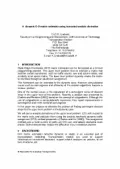-
Past ETC Papers

Browse, search and view papers from the past AET Conferences.
-
Members' Area

AET promotes networking and exchange of ideas, information and opportunities amongst members.
Conference Papers 2002
Cambridge, United Kingdom
ETC Conference Papers 2002
A dynamic O-D matrix estimator using analytic derivatives
Seminar
Day 2 (10 Sep 2002), Methodological Innovations, Matrix Estimation, 19:00 - 22:00
Status
Accepted, documents submitted
Authors
C Lindveld, Delft University of Technology, NL
Abstract
Static O-D matrix estimation can be formulated as a bilevel programming problem. The upper level problem tries to make the estimated matrix satisfy certain constraints, such as traffic counts, row and column totals, and similarity to an apriori matrix. The lower level problem typically stipulates an equilibrium assignment of the matrix to a network.
This framework can be extended to the dynamic case. However, as is shown in the literature, computational issues such as convergence and efficiency of the solution algorithms become a serious issue.
One of the central issues is the calculation of a convergent series of descent step in the upper level of the problem. Recently a solution was presented by Codina and Montero based on the concept of subgradients. Although the use of subgradients is computationally expensive, the Codina and Montero report improvements in convergence and in the speed of convergence.
In this paper we propose to alleviate the problem of finding convergent descent steps for the upper level problem. Denoting the objective function of the O-D matrix T in the upper level by z(T), we can split z(T) intp a part z1(q_obs, q_model(T)) related to the assignment results and a part z2(T_apriori, T) reated to the apriori matrix, we have that z(T) = z1(T) + z2(T).
We will explicitly calculate the derivatives of the upper level problem z(t) with respect to the matrix cells, by using the analytic stochastic dynamic traffic assignment (DTA) method recently proposed by Ismail Chabini. We will use the derivatives to investigate convergence of the algorithm in a simple test case.
Documents:

Association For
European Transport
Forester House
Doctors Lane
Henley-in-Arden
Warwickshire, UK
B95 5AW
+44 (0) 15 64 793552
VAT number: 710 1866 64
Conference Supporters & Endorsers




Legal Entity
The Association for European Transport is registered as an Association ('vereniging') with the Chamber of Commerce for Haaglanden in The Netherlands under company number 27170096.
Built on Zenario




